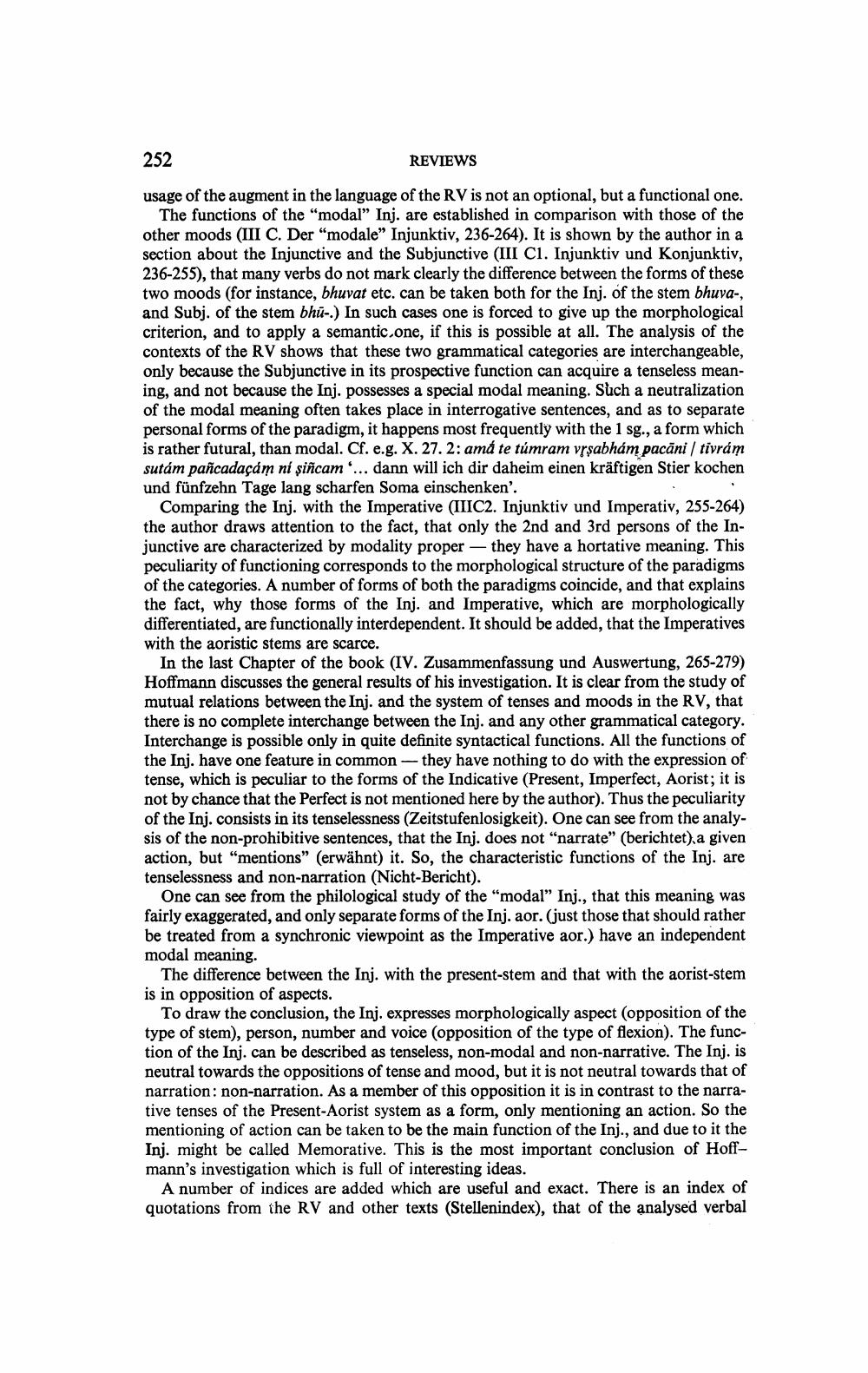Book Title: Reviews Of Different Books Author(s): Publisher: View full book textPage 6
________________ 252 REVIEWS usage of the augment in the language of the RV is not an optional, but a functional one. The functions of the "modal" Inj. are established in comparison with those of the other moods (III C. Der "modale" Injunktiv, 236-264). It is shown by the author in a section about the Injunctive and the Subjunctive (III C1. Injunktiv und Konjunktiv, 236-255), that many verbs do not mark clearly the difference between the forms of these two moods (for instance, bhuvat etc. can be taken both for the Inj. of the stem bhuva-, and Subj. of the stem bhu-.) In such cases one is forced to give up the morphological criterion, and to apply a semantic one, if this is possible at all. The analysis of the contexts of the RV shows that these two grammatical categories are interchangeable, only because the Subjunctive in its prospective function can acquire a tenseless meaning, and not because the Inj. possesses a special modal meaning. Such a neutralization of the modal meaning often takes place in interrogative sentences, and as to separate personal forms of the paradigm, it happens most frequently with the 1 sg., a form which is rather futural, than modal. Cf. e.g. X. 27.2: ama te tumram vrsabham pacani / tivram sutam pancadacam ni sincam.... dann will ich dir daheim einen kraftigen Stier kochen und funfzehn Tage lang scharfen Soma einschenken'. Comparing the Inj. with the Imperative (IIIC2. Injunktiv und Imperativ, 255-264) the author draws attention to the fact, that only the 2nd and 3rd persons of the Injunctive are characterized by modality proper -- they have a hortative meaning. This peculiarity of functioning corresponds to the morphological structure of the paradigms of the categories. A number of forms of both the paradigms coincide, and that explains the fact, why those forms of the Inj. and Imperative, which are morphologically differentiated, are functionally interdependent. It should be added, that the Imperatives with the aoristic stems are scarce. In the last Chapter of the book (IV. Zusammenfassung und Auswertung, 265-279) Hoffmann discusses the general results of his investigation. It is clear from the study of mutual relations between the Inj. and the system of tenses and moods in the RV, that there is no complete interchange between the Inj. and any other grammatical category. Interchange is possible only in quite definite syntactical functions. All the functions of the Inj. have one feature in common - they have nothing to do with the expression of tense, which is peculiar to the forms of the Indicative (Present, Imperfect, Aorist; it is not by chance that the Perfect is not mentioned here by the author). Thus the peculiarity of the Inj. consists in its tenselessness (Zeitstufenlosigkeit). One can see from the analysis of the non-prohibitive sentences, that the Inj. does not "narrate" (berichtet), a given action, but "mentions" (erwahnt) it. So, the characteristic functions of the Inj. are tenselessness and non-narration (Nicht-Bericht). One can see from the philological study of the "modal" Inj., that this meaning was fairly exaggerated, and only separate forms of the Inj. aor. (just those that should rather be treated from a synchronic viewpoint as the Imperative aor.) have an independent modal meaning. The difference between the Inj. with the present-stem and that with the aorist-stem is in opposition of aspects. To draw the conclusion, the Inj. expresses morphologically aspect (opposition of the type of stem), person, number and voice (opposition of the type of flexion). The function of the Inj. can be described as tenseless, non-modal and non-narrative. The Inj. is neutral towards the oppositions of tense and mood, but it is not neutral towards that of narration: non-narration. As a member of this opposition it is in contrast to the narrative tenses of the Present-Aorist system as a form, only mentioning an action. So the mentioning of action can be taken to be the main function of the Inj., and due to it the Inj. might be called Memorative. This is the most important conclusion of Hoffmann's investigation which is full of interesting ideas. A number of indices are added which are useful and exact. There is an index of quotations from the RV and other texts (Stellenindex), that of the analysed verbalPage Navigation
1 ... 4 5 6 7 8 9 10 11 12 13 14 15 16 17 18 19 20 21 22 23 24 25 26 27 28 29 30 31 32 33 34 35 36 37 38 39 40 41 42 43 44 45 46 47 48
